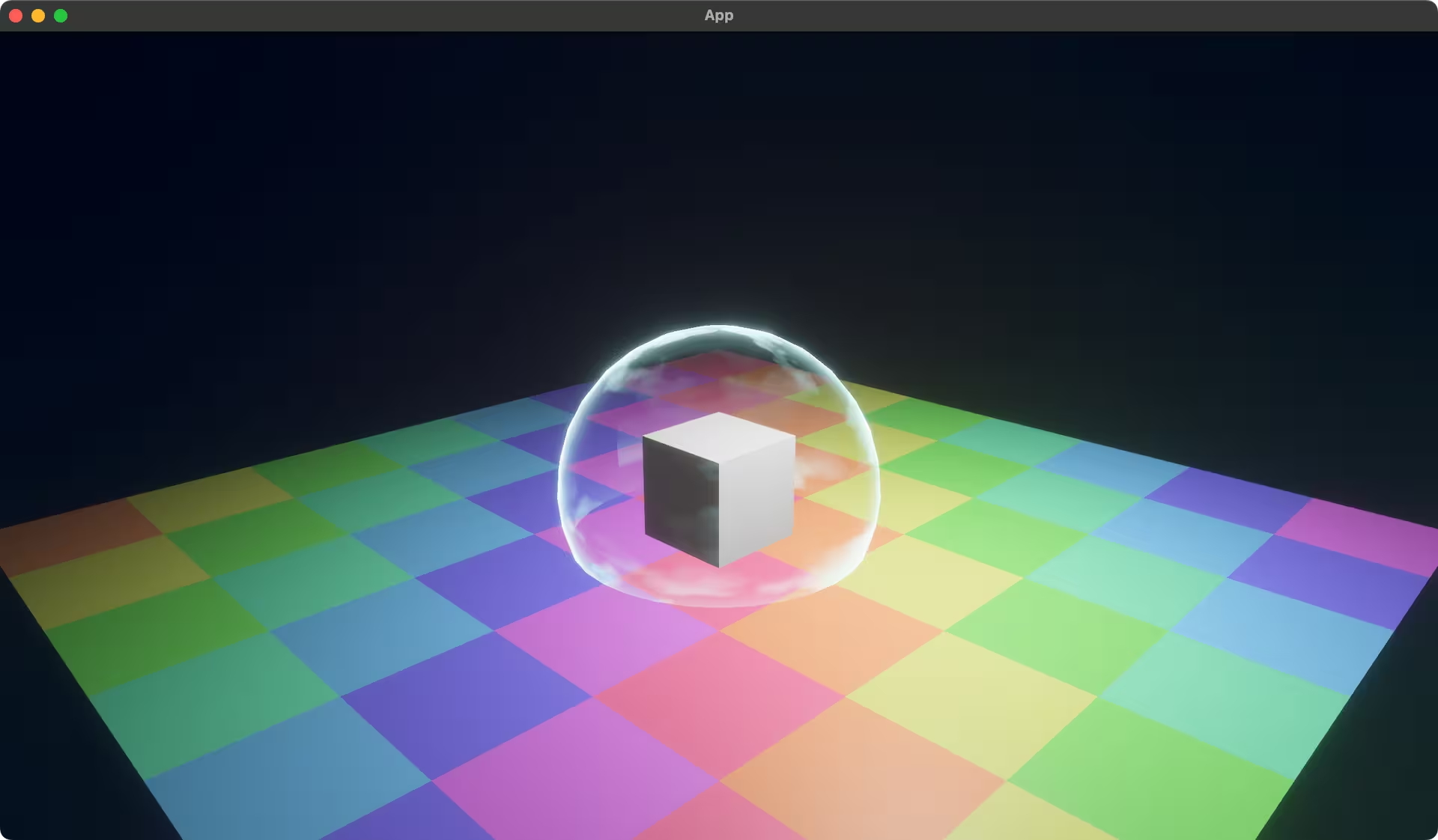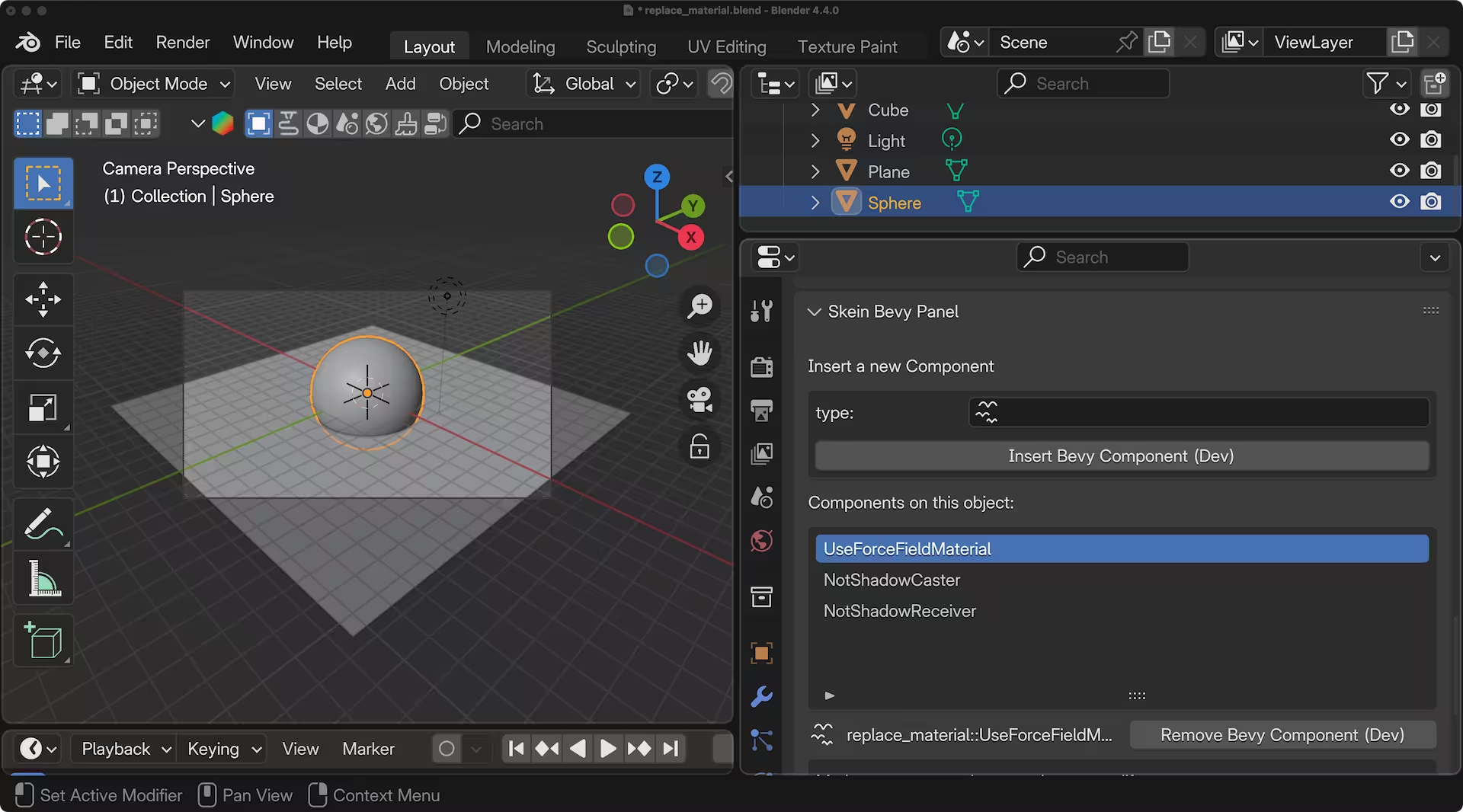Use Cases
Replace a Blender Material
Its not uncommon to want to define materials in Blender and replace them with custom shaders in Bevy. For example, in Blender you could define a "Force Field" material. This material would import into Bevy as a regular StandardMaterial and be applied to any objects it was applied to in Blender.
If you utilize Hooks and Observers you can define a marker component that will be inserted alongside this Material, allowing you to replace it with custom shaders utilizing all of Bevy's features.

A Bevy Material
We'll define a ForceFieldMaterial that is based on the Bevy 0.10 Release Notes Depth and Normals Demo.
View the shader logic over on GitHub if you want to, but returning a flat color would also work for this example.
// This is the struct that will be passed to your shader
#[derive(Asset, TypePath, AsBindGroup, Debug, Clone)]
struct ForceFieldMaterial {}
impl Material for ForceFieldMaterial {
fn fragment_shader() -> ShaderRef {
"shaders/force_field.wgsl".into()
}
fn alpha_mode(&self) -> AlphaMode {
AlphaMode::Add
}
fn specialize(
_pipeline: &bevy::pbr::MaterialPipeline<Self>,
descriptor: &mut bevy::render::render_resource::RenderPipelineDescriptor,
_layout: &bevy::render::mesh::MeshVertexBufferLayoutRef,
_key: bevy::pbr::MaterialPipelineKey<Self>,
) -> Result<(), bevy::render::render_resource::SpecializedMeshPipelineError>{
descriptor.primitive.cull_mode = None;
Ok(())
}
}
Marker Components and Hooks
We'll use a Component's on_add hooks to replace materials defined in Blender with our force field when the Bevy application runs.
In Blender, a Component (UseForceField in this example) can be added to a Material using the Materials Panel as detailed in Inserting Components.
Any object this Material is attached to will also have this Component.

This UseForceFieldMaterial has an on_add hook that replaces the StandardMaterial with a Bevy handle to another material.
#[derive(Component, Reflect)]
#[reflect(Component)]
#[component(on_add = on_add_use_force_field_material)]
struct UseForceFieldMaterial;
/// The on_add hook that will run when the component is
/// added when spawning the glTF scene.
fn on_add_use_force_field_material(
mut world: DeferredWorld,
HookContext { entity, .. }: HookContext,
) {
let force_field = world
.resource::<MaterialStore>()
.force_field
.clone();
world
.commands()
.entity(entity)
.remove::<MeshMaterial3d<StandardMaterial>>()
.insert(MeshMaterial3d(force_field));
}
Storing Material Handles
Tip
In this example we create and store the material handle in a Resource at startup, allowing us to re-use the handle as many times as needed. You could use a HashMap instead to handle many handles like this or ignore it completely and recreate the material if you don't care.
#[derive(Resource)]
struct MaterialStore {
force_field: Handle<ForceFieldMaterial>,
}
fn setup(
mut commands: Commands,
mut materials_force_field: ResMut<
Assets<ForceFieldMaterial>,
>,
) {
// Create and insert a handle to the debug material
// as a Resource we can access later
commands.insert_resource(MaterialStore {
force_field: materials_force_field.add(ForceFieldMaterial {}),
});
}
Trobuleshooting: UVs
Caution
Any mesh that hasn't been UV unwrapped may seem like it isn't working. This shows up in .gltf files as a missing TEXCOORD_0 field. Suzanne in the following example glTF data has it, and rock does not. This is something you can check for in Blender.
{
"name":"Suzanne",
"primitives":[
{
"attributes":{
"POSITION":28,
"NORMAL":29,
"TEXCOORD_0":30
},
"indices":31,
"material":0
}
]
},
{
"name":"rock",
"primitives":[
{
"attributes":{
"POSITION":32,
"NORMAL":33
},
"indices":34,
"material":0
}
]
},